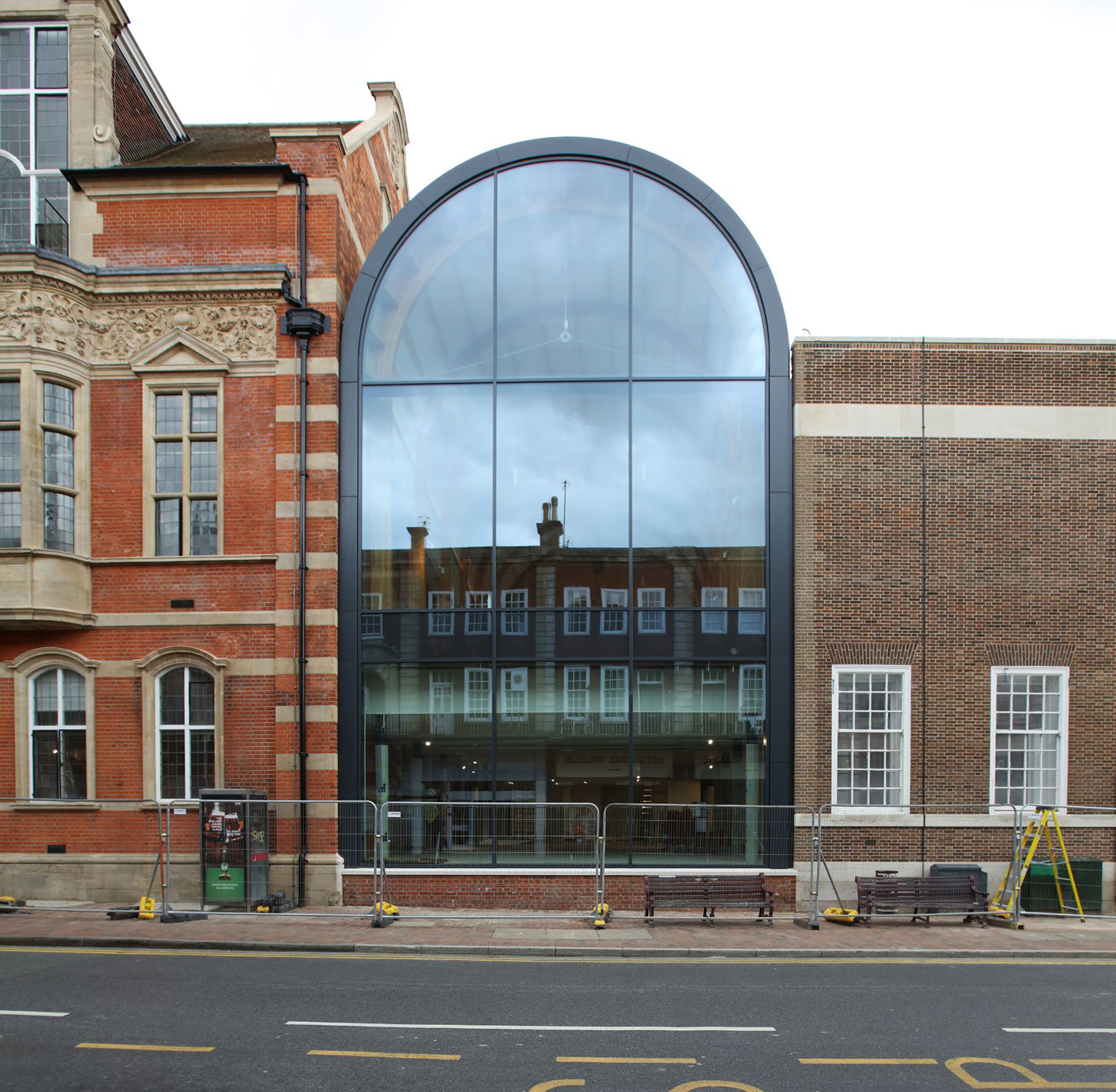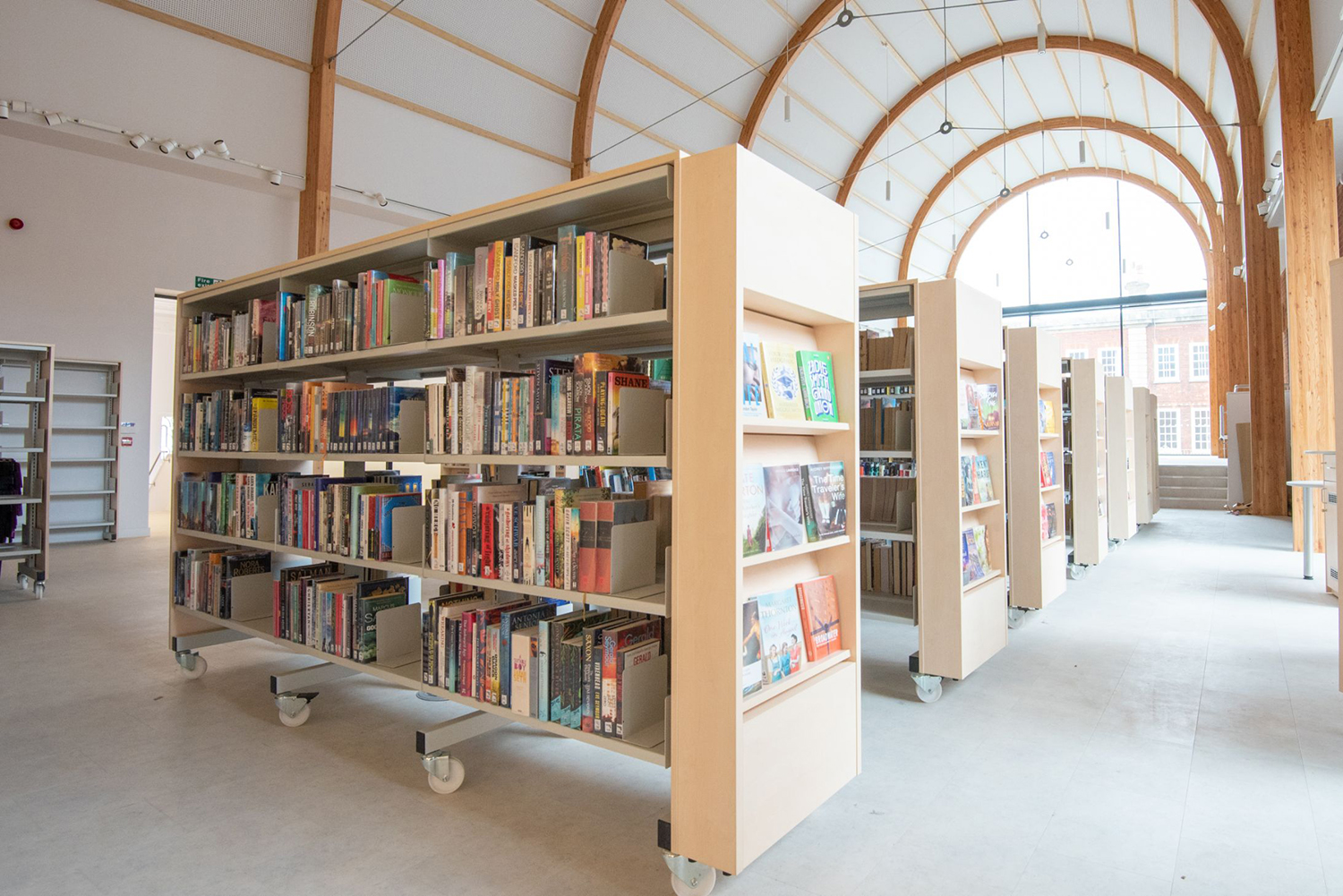The Amelia Scott Centre has been a complex heritage and refurbishment project for Willmott Dixon Interiors, which involved joining together two existing buildings. CM reports.
Willmott Dixon Interiors has been building a new cultural centre in the Kent spa town of Tunbridge Wells over the past two-and-a-half years. Named after local suffragette and social reformer Amelia Scott, the project has been a complex construction operation, involving linking and refurbishing two landmark buildings, one of which is Grade II-listed.
Willmott Dixon began work on the £14m project in Tunbridge Wells town centre in January 2020. The scheme centred on a grand, four-storey library dating from 1952 and an adjacent three-storey adult education centre built in 1904, which retains many period features.
These buildings have been connected by an airy barrel-vaulted central lobby 15m high, and the interiors stripped back and refurbished. Built onto the back of the library, and helping to form a sun-capturing courtyard, is a new two-storey archive wing.
Amelia Scott Centre – project details
Client: Tunbridge Wells Borough Council
Main contractor: Willmott Dixon Interiors
Client architect: Purcell
Client project manager: Spider
Programme start: January 2020
Programme completion: May 2022
Value: £14m
The Amelia Scott Centre comprises the upgraded adult education centre and library, plus a museum, art gallery, archives including a historic photographic collection, a tourist information centre and a new cafe which opens out onto the courtyard at the rear.
The guiding concept of the 4,000 sq m project has been to create a symbiotic relationship between all areas of the building, so that students taking, say, silversmithing classes in the adult education centre, can easily access the library for research and the art gallery for displaying their workmanship.
Similarly, library users inspired to develop their skills and knowledge can circulate smoothly around the various cultural and educational facilities on offer.
Heritage and refurbishment challenges
The project was led by Duncan Booth, Willmott Dixon Interiors project manager, after working on another heritage scheme, the Old Admiralty building in London. “Although that was a bigger project, the Old Admiralty and the Amelia Centre are quite similar in terms of structure and materials,” he says.
As ever with refurbishment, the challenge in Tunbridge Wells was twofold: dealing with what lay concealed in the walls and structural framework; and shoehorning modern services into old buildings. Here, copious quantities of asbestos behind the panellings was revealed along with multiple corridors and walls lined with rotten plasterwork. Installing the services was made somewhat easier, however, by the fact that so much had to be stripped back, improving access.

“It was a complete strip back and refurbishment project, but we had to retain much of the original buildings, including doors, ironmongery and the plaster skirting boards,” says Booth.
“Because the original plaster was made from lime and horsehair, we had to employ a specialist to mix similar plaster for the replacement to meet the conservation requirements. Replastering the walls of lots of high-ceilinged rooms became a painstaking, time-consuming job – and the plaster then needed months to dry properly.”
The refurbishments were complicated by the variety of the materials and construction methods used for the existing library buildings. The 1950s library, sited over a Second World War bomb shelter, was built with whatever materials were available under the still-operating rationing system.

Willmott Dixon’s team found an assortment of bricks, cavity walls and concrete slabs, all of which had to be picked apart and reconfigured. It was equally testing in the old adult education centre, where the team discovered a mixture of brickwork and steel and timber joists infilled with clinker concrete.
Firming up project costings
When the team arrived on site in spring 2019 to firm up project costings, the first challenge was to find ways of reconciling the clients’ ambitions with the available budget.
Various value-engineering suggestions needed approval by committees at both Kent County Council (KCC) and Tunbridge Wells Borough Council (TWBC) as well as their architect Purcell and project manager Spider. This was a complex command structure, and one which the Willmott Dixon team had to negotiate their way around throughout the project’s numerous inevitable variations.
Having persuaded the team to modify certain aspects of the design, the client pressed the button on construction work on site in January 2020, about six months behind the original programme.

CV: Duncan Booth MCIOB
Since joining Willmott Dixon six years ago, construction manager Duncan Booth has become a heritage specialist. He worked on the Old Admiralty project in Westminster, a famous rabbit warren of a building with more than 650 rooms, where Winston Churchill once had his office. From there he moved onto the Amelia Scott Centre.
Prior to Willmott Dixon, he worked as a contracts manager for ITC Concepts on the Enfield Civic Centre refurbishment, for Guernsey contractor J W Rihoy, and at Killby & Gayford.
The heavy-duty parts of the programme, which created 4,000 tonnes of muckaway, followed a relatively straightforward path. First, demolition of the outbuildings, lay foundations for the new archive building. Then the areas at the back of the library were demolished, and the reinforced concrete poured for the new archive wing, with its 1m thick walls. The foundations and ground floor slabs for the central lobby that serves as a connecting bridge between the two buildings were then laid.
The foundations and floor slabs complete, Willmott Dixon installed glulam beams in the central lobby, and a cone-shaped roof overhead, using a grey-coloured section of curtain walling. Replastering and services installation took place afterwards or alongside all the various structural activities.
To be eligible for hosting exhibitions of important works of art from other galleries, the Amelia Centre’s administrators had to apply to the Arts Council for insurance cover under the Government Indemnity Scheme. This meant the section of the building containing the art gallery was built to a set of very exacting criteria which stipulated ventilation levels and various additional building standards.
Environmental features
Eco credentials are high, despite the large Edwardian windowpanes in the adult education centre and the lobby, for which the secondary glazing employed in the library was not suitable. Wherever possible, the external walls were thickened to achieve high insulation values. Willmott Dixon also installed heat recovery pumps and 95 photovoltaic panels on the roof.
Biodiversity features include bird and bat nests in holes drilled high up all round the outside of the building.
Almost throughout the whole length of the project, the team had to deal with restrictions and logistical pressures brought about by the Covid pandemic. “We enforced the rules and expected our supply chain to do the same – and they did,” says Booth. “Social distancing on site was strictly observed. Any sniffles on site were tested and if the result was positive, that team member was sent home immediately. We had about five cases in all, which really wasn’t very many for a site that had 130 people every day at peak.”

Nevertheless, Covid did have an impact on the programme, Booth explains: “Delays crept in because of lockdown. It sometimes caused driver shortages, and materials were sometimes late arriving.”
His verdict on Covid’s overall impact: “It could have been better, but equally, it could have been a whole lot worse.”
At many stages during the project, Booth’s team have walked the various stakeholders around and tried to maintain a collaborative approach to the project.
The Amelia Scott Centre opened its doors in May 2022. Amelia Scott, who in 1919 was one of the first two women elected to the local borough council, would surely approve of the use of local authority funding, topped up by National Lottery Heritage grants, to create such an attractive and modern multi-purpose cultural hub, open to one and all.










